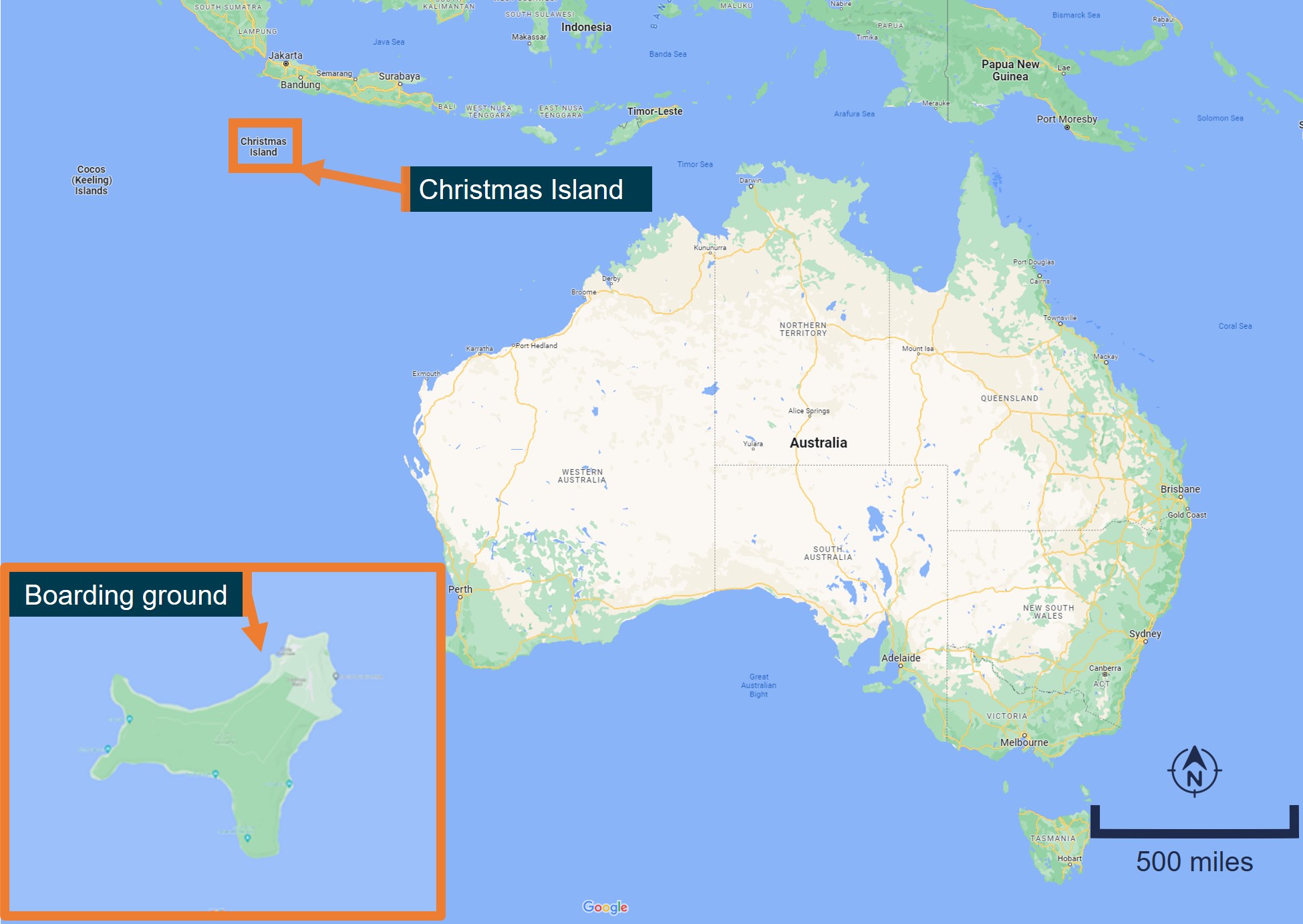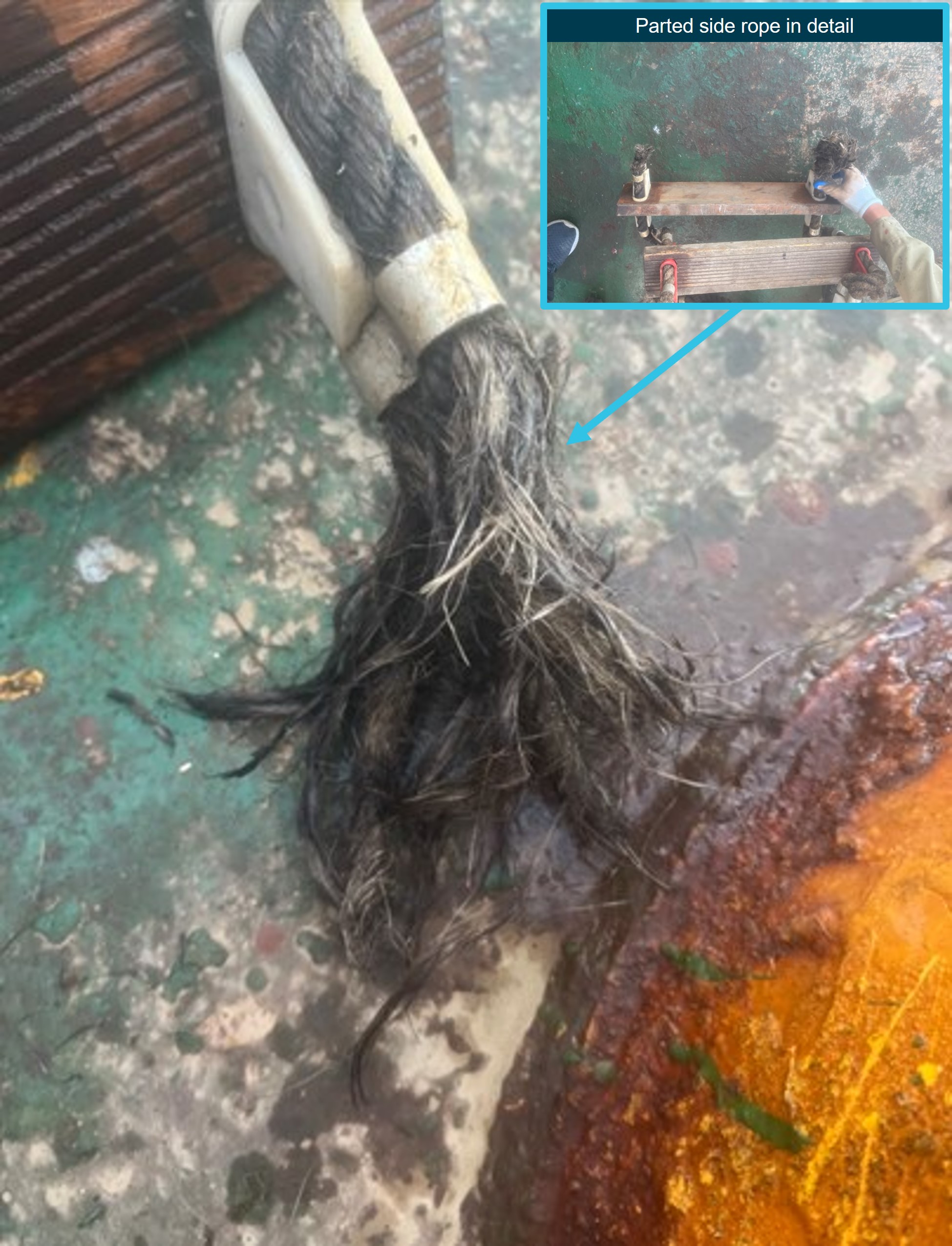What happened
At about 0520 local time on 24 May 2023, a 117 m general cargo ship arrived at Christmas Island pilot boarding ground (Figure 1) from Semarang, Indonesia, in preparation to board a harbour pilot to berth for loading cargo. The crew prepared the ship’s pilot ladder and accommodation ladder (combination ladder)[1] on the starboard side with the pilot ladder positioned 1 m above the water line in accordance with the pilot’s requirement and standard procedure.
Figure 1: Territory of Christmas Island, Australia

Source: Google annotated by ATSB.
At about 0630, the pilot vessel with a pilot and two mooring master stevedores on board arrived at the pilot boarding ground. The pilot boarded the ship using the combination ladder without incident and waited on deck for the mooring masters to board. The first mooring master started ascending the pilot ladder while the pilot vessel moved clear of the ship as per its usual practice. When the mooring master was approximately halfway up the ladder (about 4 m above the waterline) both side ropes of the ladder parted suddenly at the ship’s main deck level and the mooring master and ladder fell into the water (Figure 2).
Figure 2: Failed pilot ladder suspended below accommodation ladder

Source: Harbour pilot
The mooring master’s lifejacket inflated automatically in the water, and they were recovered a short time later by the pilot vessel. The mooring master had minor injuries. The pilot cancelled the ship’s berthing and, after a replacement pilot ladder was rigged and tested, disembarked.
Subsequently, the pilot reported the incident to the Australian Maritime Safety Authority (AMSA) and it issued a detention order for the ship. Two days later, on 26 May 2023, an AMSA inspector arrived at Christmas Island from Fremantle and carried out a Port State Control (PSC) inspection. The PSC inspection included an assessment of the failed pilot ladder’s condition (Figure 3) and compliance with relevant legislation.[2] The findings of the inspection resulted in AMSA initiating regulatory action against the ship’s owners and master.
Figure 3: Pilot ladder side rope failure point

Source: Harbour pilot
Pilot transfer arrangements
Personnel transfer via pilot ladders and combination ladders is a high risk, routine activity regularly undertaken by marine pilots and seafarers globally. The International Convention for the Safety of Life at Sea (SOLAS)[3] sets out the minimum requirement for boarding arrangements and requires pilot ladders to be regularly inspected in accordance with SOLAS regulations and be certified by the manufacturer as compliant with those regulations.
The International Organization for Standardization (ISO) standard ISO 799:2004, Ships and marine technology – Pilot ladders, is cited in SOLAS as an example of an acceptable standard. Additionally, the ISO standard requires that pilot ladders shall be inspected and subjected to strength testing at not more than 30-month intervals or replaced.
Ship owners and masters can meet their obligations when the ship’s pilot ladder has been certified by the manufacturer that it complies with the requirements of either SOLAS, ISO 799-1 or another internationally recognised equivalent standard.
Compliance issues
The AMSA Marine Notice 04/2023 provides guidance on pilot transfer arrangements and highlights the issues due to regular non-compliance with these arrangements. The notice also states that that since November 2017, multiple separate incidents involving the failure of a pilot ladder securing point or man-ropes[4] had been reported.
The United Kingdom’s Marine Accident Investigation Branch’s (MAIB) 2021 Annual Report noted that for the 2021 calendar year it had received 194 reports about sub-standard pilot ladders. Further, of those, 172 were not rigged in compliance with SOLAS and 22 were in a poor condition. The MAIB highlighted key safety messages on pilot ladder use in its Safety Digest 1/2022.
The International Maritime Pilots’ Association (IMPA) published Safety Survey 2022 and reported 783 of 4,664 responses to its member survey identified transfer arrangements as non-compliant (about 17%). This was consistent with previous IMPA surveys, and it emphasised ‘…persistent non-compliance’ with SOLAS required improved awareness of pilot ladder safety amongst both crew and owners. Further, IMPA considered SOLAS Chapter V, Regulation 23, associated IMO instruments and the ISO 799 series of standards as the minimum standard, not an aspirational target.
Safety action
The harbour pilot advised the ATSB that an internal investigation into the incident had been undertaken and, as an interim measure, all ships are required to declare the actual age of the pilot ladder (certificate date) instead of the previous practice of the master declaring the ladder was in ‘first class condition’.
In addition, the Christmas Island Port Information Guide for Ship's Masters has been amended to highlight the compliance requirements of Marine Orders and SOLAS. Further, local requirements added to the guide require, in part, that ships calling at the Port of Christmas Island must not use pilot ladders beyond 30 months from the date received on board unless they have been strength tested as per ISO 799-1.
Safety message
Personnel transfers via pilot ladders is routine practice internationally but remains one where accidents and near-accidents regularly occur. While relevant regulations do not specify pilot ladder inspection and replacement intervals, shipowners, operators, masters, and crews are reminded that there exists a mutual obligation to provide safe pilot transfer arrangements, including that pilot ladders must comply with the requirements of SOLAS Chapter V, Regulation 23.
About this report
Decisions regarding whether to conduct an investigation, and the scope of an investigation, are based on many factors, including the level of safety benefit likely to be obtained from an investigation. For this occurrence, no investigation has been conducted and the ATSB did not verify the accuracy of the information. A brief description has been written using information supplied in the notification and any follow-up information in order to produce a short summary report, and allow for greater industry awareness of potential safety issues and possible safety actions.
[1] The use of a ship’s pilot ladder in conjunction with the ship’s accommodation ladder is also referred to as a combination ladder.
[2] See section on Pilot transfer arrangements.
[3] International Maritime Organisation (IMO), 1974, The International Convention for the Safety of Life at Sea, 1974, as amended (SOLAS 1974), IMO, London
[4] Man-ropes are two ropes of not less than 28 mm and not more than 32 mm diameter secured to the ship in addition to the pilot ladder if required by the pilot. They are placed either side of the pilot ladder and fixed at the rope end to a ring plate fixed on the ship’s deck.


